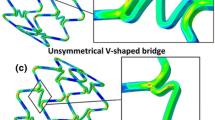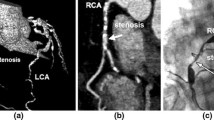Abstract
Vascular stents have emerged as an effective treatment for occlusive vascular disease. Despite their success and widespread use, outcomes for patients receiving stents are still hampered by thrombosis and restensosis. As arteries attempt to adapt to the mechanical changes created by stents, they may in fact create a new flow-limiting situation similar to that which they were intended to correct. In vitro fluid mechanics and solid mechanics studies of stented vessels have revealed important information about how stents alter the mechanical environment in the arteries into which they are placed. Adverse nonlaminar flow patterns have been demonstrated as well as remarkably high stress concentrations in the vessel wall. In vivo studies of stented vessels have also shown a strong relationship between stent design and their dynamic performance within arteries. Alterations in pressure and flow pulses distal to the stent have been observed, as well as regional changes in vascular compliance. Considering the influence of flow and stress on the vascular response and the suboptimal clinical outcomes associated with stenting, knowledge gained from stent/artery mechanics studies should play an increasingly important role in improving the long-term patency of these devices. © 2002 Biomedical Engineering Society.
PAC2002: 8719Rr, 8780-y, 8719Uv
Similar content being viewed by others
REFERENCES
Abbott, W. M., J. E. Megerman, J. E. Hasson, G. L'Italien, and D. F. Warnock. Effect of compliance mismatch on vascular graft patency. J. Vasc. Surg. 5:376–382, 1987.
Back, M., G. Kopchok, M. Mueller, D. Cavaye, C. Donayre, and R. A. White. Changes in arterial wall compliance after endovascular stenting. J. Vasc. Surg. 19:905–911, 1994.
Ballyk, P. D., C. Walsh, J. Butany, and M. Ojha. Compliance mismatch may promote graft-artery intimal hyperplasia by altering suture-line stresses. J. Biomech. 31:229–237, 1998.
Banes, A. J. Mechanical strain and the mammalian cell. In: Physical Forces and the Mammalian Cell, edited by J. A. Frangos. New York: Academic, 1993, pp. 81–123.
Berry, J. L., E. Manoach, C. Mekkaoui, P. H. Rolland, J. E. Moore, Jr. and A. Rachev. Hemodynamics and wall mechanics of a compliance matching stent: In vitro and in vivo analysis. J. Vasc. Intervent Radiol. 13:97–105, 2002.
Berry, J. L., J. E. Moore, Jr., V. S. Newman, and W. D. Routh. In vitro flow visualization in stented arterial segments. J. Vasc. Invest. 3:63–68, 1997.
Berry, J. L., A. Santamarina, J. E. Moore, Jr., S. Roychowdhury, and W. D. Routh. Experimental and computational flow evaluation of coronary stents. Ann. Biomed. Eng. 28:386–398, 2000.
Berthiaume, F., and J. A. Frangos. Effects of flow on anchorage-dependent mammalian cells-secreted products. In: Physical Forces and the Mammalian Cell, edited by J. A. Frangos. New York: Academic, 1993, pp. 139–192.
Cantelmo, N. L., W. C. Quist, and F. W. Logerfo. Quantitative analysis of anastomotic intimal hyperplasia in paired dacron and PTFE grafts. J. Cardiovasc. Surg. 30:910–915, 1989.
Delfino, A., N. Stergiopulos, J. E. Moore, Jr., and J. J. Meister. Residual strain effects on the stress field in a thick wall finite element model of the human carotid bifurcation. J. Biomech. 30:777–786, 1997.
Depaola, N., M. A. Gimbrone, P. F. Davies, and C. F. Dewey. Vascular endothelium responds to fluid shear stress gradients. Arterioscler. Thromb. 12:1254–1257, 1992.
DeWeese, J. A. Anastomotic neointimal fibrous hyperplasia. In: Complications in Vascular Surgery, edited by V. M. Brenhard and J. B. Towne. Orlando, 1985.
Dotter, C. T. Transluminally placed coilspring endarterial tube grafts: Long term patency in canine popliteal artery. Invest. Radiol. 4:329–332, 1969.
Dotter, C. T., R. W. Buschman, M. K. McKinney, and J. Rösch. Transluminal expandable nitinol coil stent grafting: Preliminary report. Radiology 147:259–260, 1983.
Duerig, T. W., D. E. Tolomeo, and M. Wholey. An overview of superelastic stent design. Min. Invas. Ther. Allied Technol. 9:235–246, 2000.
Echave, V., A. R. Koornick, M. Haimov, and J. H. Jacobson. Intimal hyperplasia as a complication of the use polytetrafluoroethylene grafts for femoral-popliteal bypass. Surgery (St. Louis) 86:791–798, 1979.
Edelman, E. R., and C. Rogers. Pathobiologic responses to stenting. Am. J. Cardiol. 81:4E–6E, 1998.
Fabregues, S., K. Baijens, R. Rieu, and P. Bergeron. Hemodynamicsof endovascular prostheses. J. Biomech. 31:45–54, 1998.
Fischman, D. L., M. B. Leon, D. S. Baim, R. A. Schatz, M. P. Savage, I. Penn, and K. Detre. A randomized comparison of coronary artery stent placement and balloon angioplasty in the treatment of coronary artery disease. N. Engl. J. Med. 331:496–501, 1994.
Formaggia, L., F. Nobile, and A. Quarteroni, A one dimensional model for blood flow: Application to vascular prosthesis. In: MSCOM 2000, edited by T. Miyoshi. Berlin: Springer, 2001.
Fung, Y. C. What are residual stresses doing in our blood vessels? Ann. Biomed. Eng. 19:237–249, 1991.
He, X., and D. N. Ku. Pulsatile flow in the human left coronary artery bifurcation: average conditions. J. Biomech. Eng. 118:74–82, 1996.
Heidekker, M. A., C. R. White, N. L'Heureux, and J. A. Frangos. Analysis of temporal shear stress gradients during the onset phase of flow over a backward-facing step. J. Biomech. Eng. (in press).
Henry, F. S. Flow in stented arteries. In: Intra-and Extracorporeal Cardiovascular Fluid Dynamics, edited by P. Verdonck and K. Perktold. Boston: WIT, 2000, pp. 333–364.
Hoffmann, R., G. S. Mintz, K. Kent, L. Satler, A. Pichard, J. Popma, and M. Leon. Serial intravascular ultrasound predictors of restenosis at the margins of Palmaz-Schatz stents. Am. J. Cardiol. 79:951–953, 1997.
Hoffman, R., G. S. Mintz, G. R. Dussaillant, J. J. Popma, A. D. Pichard, L. F. Satler, K. M. Kent, J. Griffin, and M. B. Leon. Patterns and mechanisms of in-stent restenosis. A serial intravascular ultrasound study. Circulation 94:1247–1254, 1996.
Humphrey, J., and S. Na. Elastodynamics and arterial wall stress. Ann. Biomed. Eng. (to be published).
Kastrati, A. J., J. Mehilli, J. Dirschinger, J. Pache, K. Ulm, H. Schühlen, M. Seyfarth, C. Schmitt, R. Blasini, F.-J. Neumann, and A. Schömig. Restenosis after coronary placement of various stent types. Am. J. Cardiol. 87:34–39, 2001.
Ku, D. N., D. P. Giddens, C. R. Zarins, and S. Glagov. Pulsatile flow and atherosclerosis in the human carotid bifurcation: Positive correlation between plaque localization and low and oscillating shear stress. Arteriosclerosis (Dallas) 5:293–302, 1985.
Logerfo, F. W., W. C. Quist, M. D. Nowak, H. M. Cranshaw, and C. C. Haudenschild. Downstream anastomotic hyperplasia: A mechanism of failure in dacron arterial grafts. Arch. Surg. (Chicago) 197:479–483, 1983.
Mohammed, Z., J. E. Moore, Jr., A. Rachev, J. L. Berry, and E. Manoach. Stress concentration reduction in stented arteries using compliance transitioning. Int. J. Cardiovasc. Med. Sci. 3:137–147, 2000.
Moore, Jr., J. E., C. Xu, S. Glagov, C. K. Zarins, and D. N. Ku. Fluid wall shear stress measurements in a model of the human abdominal aorta: Oscillatory behavior and the relationship to atherosclerosis. Arteriosclerosis (Dallas) 110:225–240, 1994.
Natarajan, S., and M. Mokhtarzadeh. A numerical and experimental study of periodic flow in a model of a corrugated vessel with application to stented arteries. Med. Eng. Phys. 22:555–566, 2000.
Palmaz, J. C., G. M. Richter, G. Noldge, G. W. Kauffmann, and W. Wenz. Intraluminal Palmaz stent implantation. The first clinical case report on a balloon-expanded vascular prosthesis. [German]. Radiologe 27:560–5633, 1987.
Palmaz, J. C., D. T. Kopp, and H. Hayashi. Normal and stenotic renal arteries: Experimental balloon-expandable intraluminal stenting. Radiology 164:705, 1987a.
Peacock, J., S. Hankins, T. Jones, and R. Lutz. Flow instabilities induced by coronary artery stents: Assessment with an in vitro pulse duplicator. J. Biomech. 28:17–26, 1995.
Perktold, K. Ann. Biomed. Eng. (to be published).
Rachev, A., E. Manoach, J. L. Berry, and J. E. Moore, Jr.. Model of stress induced remodeling of vessel segments adjacent to stents and artery/graft anastomoses. J. Theor. Biol. 206:429–443, 2000.
Rhee, K., and J. M. Tarbell. A study of the wall shear rate distribution near the end-to-end anastomosis of a rigid graft and compliant artery. J. Biomech. 27:329–338, 1994.
Rockwell, D. Vortex-body interactions. Annu. Rev. Fluid Mech. 30:199–229, 1998.
Rogers, C., and E. R. Edelman. Endovascular stent design dictates experimental restenosis and thrombosis. Circulation 91:2995–3001, 1995.
Rogers, C., M. A. Kjelsberg, P. Seifert, and E. R. Edelman. Heparin-coated stents eliminate mural thrombus deposition for days without affecting restenosis. (Abstract) Circulation 9(Suppl. 1):1–710, 1997
Rogers, C., D. Y. Tseng, J. C. Squire, and E. R. Edelman. Balloon-artery interactions during stent placement. Circ. Res. 84:378–383, 1999.
Rolland, P. H., A-B. Charifi, C. Verrier, H. Bodard, A. Friggi, P. Piquet, G. Moulin, and J.-M. Bartoli. Hemodynamics and wall mechanics after stent placement in swine iliac arteries: comparative results from six stent designs. Radiology 213:229–246, 1999.
Sato, M. Ann. Biomed. Eng. (to be published).
Schajer, G. S., S. I. Green, A. P. Davis, and Y. N. H. Hsiang. Influence of elastic nonlinearity on arterial anastomotic compliance. J. Biomech. Eng. 118:445–451, 1996.
Sigwart, U., J. Puel, V. Mirkovitch, F. Joffre, and L. Kappenberger. Intravascular stents to prevent occlusion and restenosis after transluminal angioplasty. N. Engl. J. Med. 316:701–706, 1987.
Simon, C., J. C. Palmaz, and E. A. Sprague. Influence of topography on endothelization of stents: Clues for new designs. J. Long-Term Effects Med. Implants 10:143–151, 2000.
Sprague, E. A., J. Luo, and J. C. Palmaz. Human aortic endothelial cell migration onto stent surfaces under static and flow conditions. J. Vasc. Interventional Radiology 8:83–92, 1997.
Stanek, B., D. Liepsch, and G. Pflugbeil. Flow studies of stents in models of the carotid artery. Third World Congress of Biomechanics. 1998, p. 206a.
Stewart, S. F. C., and D. J. Lyman. Effects of a vascular graft/natural artery compliance mismatch on pulsatile flow. J. Biomech. 25:297–310, 1992.
Sukavaneshvar, S., G. M. Rosa, and K. A. Solen. Enhancement of stent-induced thromboembolism by residual stenoses: Contribution of hemodynamics. Ann. Biomed. Eng. 28:182–193, 2000.
Tominaga, R., H. E. Kambic, H. Emoto, H. Harasaki, C. Sutton, and J. Hollman. Effects of design geometry of intravascular endoprostheses on stenosis rate in normal rabbits. Am. Heart J. 123:21–28, 1992.
Topol, E. J. Coronary-artery stents-gauging, gorging and gouging. N. Engl. J. Med. 339:1702–1704, 1998.
Truskey, G. A., K. M. Barber, T. C. Robey, L. A. Olivier, and M. P. Combs. Characterization of a sudden expansion flow chamber to study the response of endothelium to flow recirculation. J. Biomech. Eng. 117:203–210, 1995.
Truskey, G. A. et al. Effect of fluid shear stress on the permeability of the arterial endothelium. Ann. Biomed. Eng. (to be published).
Vernhet, H., J. M. Juan, R. Demaria, M. C. Oliva-Lauraire, J. P. Senac, and M. Dauzat. Acute changes in aortic wall mechanical properties after stent placement in arteries. J. Vasc. Interventional Radiology 11:634–638, 2000.
Walsh, P. W., F. Berkani, and J. E. Moore, Jr.Stented flow chamber for endothelial cell migration studies. European Society of Biomechanics, 2000.
Wentzel, J. J., D. M. Whelan, W. J. VanDerGiessen, H. M. VanBeusekom, I. Andhyiswara, P. W. Serruys, and C. J. Slager. Coronary stent implantation changes 3D vessel geometry and 3D shear stress distribution. J. Biomech. 33:1287–1295, 2000.
Xu, X., and M. W. Collins. Fluid dynamics in stents. In: Endoluminal Stenting, edited by U. Sigwart. New York: Saunders, 1996.
Author information
Authors and Affiliations
Rights and permissions
About this article
Cite this article
Moore, J.E., Berry, J.L. Fluid and Solid Mechanical Implications of Vascular Stenting. Annals of Biomedical Engineering 30, 498–508 (2002). https://doi.org/10.1114/1.1458594
Issue Date:
DOI: https://doi.org/10.1114/1.1458594




